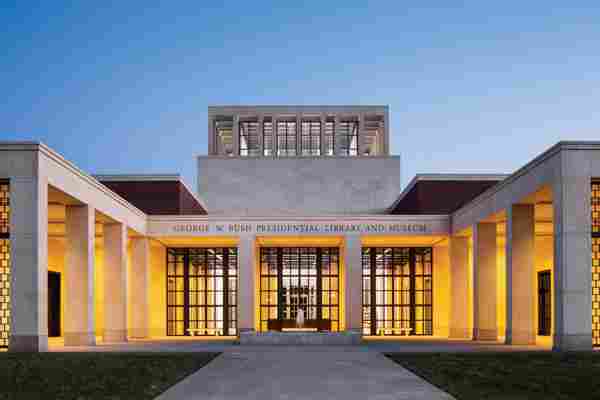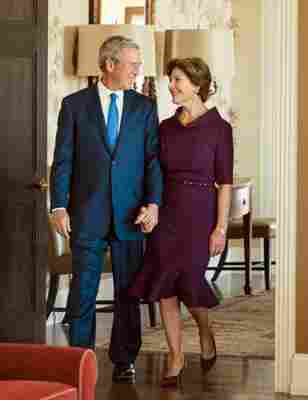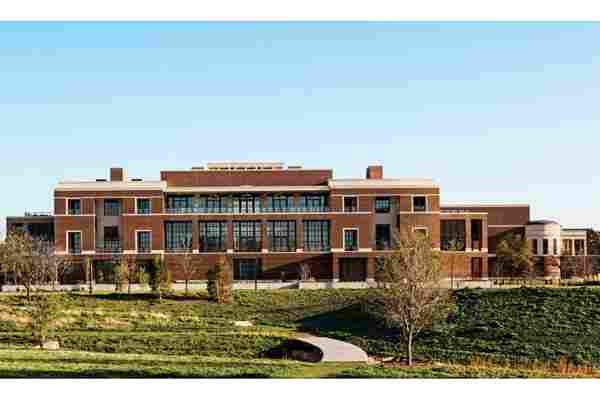View Slideshow
Visitors to the new George W. Bush Presidential Center in Dallas approach via a wide limestone path that leads to a columned entrance court centered around a simple, serene fountain. The first impression conveyed by the broad, flat-roofed three-story structure—clad in red brick and Texas Cordova Cream limestone—is of solidity and purpose. It’s a fitting tone for an institution devoted to the legacy of the 43rd president of the United States.
Open to the public on May 1, following a private, dignitary-filled dedication on April 25, the center dominates a gently sloping 23-acre site at the edge of the Southern Methodist University campus. In addition to the presidential archives, the building contains a museum, a shop, a restaurant (named Café 43), and the George W. Bush Institute, the public-policy arm of the former president’s namesake foundation. Architect Robert A.M. Stern oversaw the center’s design, while landscape architect Michael Van Valkenburgh conceived its handsome grounds, which have been planted with thousands of native trees and shrubs.
Parts of the building and landscaping were still being finished when Architectural Digest was given an advance tour of the complex, led by former first lady Laura Bush. A graduate of SMU, she began working on the project before leaving the White House and spearheaded its design committee. Standing at the entrance to the impressive edifice, she remembers that, early in the process, her husband had one primary request: “George said, ‘Don’t make this a monument to me.’”
At 226,000 square feet, the Bush center certainly is monumental in scale—as it was in cost, with the construction tab estimated at $250 million (privately raised funding for the center and its endowment reportedly will total $500 million). Yet, as Stern observes, “the building does not overwhelm. It is dignified. But it does not hit you over the head with its monumentality.”
In designing the center, Stern needed to ensure that it fit in with the SMU campus’s neoclassicism (a style he characterizes as Academic Georgian) while respecting the Bushes’ mandates that the building be progressive and environmentally responsible. As Mrs. Bush explains, “Because George was the first president of the new millennium, I wanted it to be forward and modern.”
The structure Stern has created is both modern and classical. Columns of beige limestone have been reduced to a square, minimalist essence, spacious terraces are shaded by dark aluminum brise-soleils, and walls of glass impart a sense of clarity. The Bush center “is not a Georgian building—it’s the essence of Georgian,” Stern says. “It’s carefully proportioned. It distills elements from the past but makes them respond to expectations of what a building in the 21st century should be.”



Equally important is the center’s LEED Platinum certification, the highest designation for green architecture. Its energy efficiency is enhanced by 19,000 square feet of solar panels, along with insulating green roofs and generous overhangs to provide shade and reduce air-conditioning use.
The landscaping also delivers key components of the LEED scheme. Van Valkenburgh made extensive use of water-efficient prairie plants and grasses, installed a 252,000-gallon cistern to collect rainwater for irrigation, and integrated a number of bioswales to filter runoff from the thunderstorms that roll in off the North Texas plains. He also planted nearly 1,000 native trees, including pecans, live oaks, and post oaks, and some 2,000 shrubs, from prairie roses to prickly pears. And there’s a rambling wildflower meadow, developed in consultation with the Lady Bird Johnson Wildflower Center in Austin (a bit of bipartisanship, Stern notes). A full 15 acres of the site is a public park, open from sunrise to sunset. “We wanted the center to be welcoming and environmentally friendly, like our ranch in Crawford,” says the former president.
For most visitors, the main attraction will be the museum. In addition to permanent exhibits on Mr. and Mrs. Bush’s lives and his two terms as president, there’s a full-scale replica of Bush’s Oval Office and, outside, a rose garden modeled after the one at the White House but with plantings better suited to Texas’s climate. Walking through the galleries, which include numerous state-of-the-art interactive displays, Mrs. Bush points to an area devoted to the 2000 campaign. “This is the recount,” she says, adding playfully, “A few hanging chads will be over in that case!”
The museum dedicates a major section to the events of September 11, 2001, built around a steel beam from the wreckage of the World Trade Center. Monitors show archival minute-by-minute coverage, and a wall lists the names of all those who were killed. Visitors are invited to write down or make an audio or video recording of their personal memories of that day. Following the 9/11 section are exhibits on the wars in Afghanistan and Iraq (the pistol Saddam Hussein had when he was captured is among the items on view) and on the global fight against terrorism.
Entering and exiting the galleries, guests pass through the building’s architectural centerpiece: Freedom Hall. This dramatic atrium, 67 feet high, is ringed by a massive 360-degree LED screen that shows high-definition multimedia clips blending art, history, and entertainment. Across the atrium from the permanent exhibits is an area for temporary shows and seasonal displays. And below all of this is a 65,000-square-foot space for the presidential archives, which contain some 70 million pages of paper records and 80 terabytes of electronic information. Materials will be viewable by appointment in the main-floor research room.
Separate from the center’s public areas is a wing devoted to the George W. Bush Institute, outfitted with reception rooms, seminar spaces, and a 360-seat auditorium where students, fellows, and political and business leaders can come together to address policy issues. The institute also houses offices for the George W. Bush Foundation, including those of the former president and first lady, in addition to a spacious living room and a formal dining room that seats 36. Fort Worth interior designer Kenneth Blasingame, who has worked with Mrs. Bush since the 1980s, on the couple’s Texas homes as well as on the private quarters of the White House , collaborated with her on the decor. “Mrs. Bush always said that while this building isn’t the White House, we needed to bring the dignity of the office here,” Blasingame says. “She wanted the spaces to feel presidential and elegant but also have a lightness and ease.”
Now the center is complete, and Mr. Bush gives his wife full credit for its success. “Laura perfected every detail,” he says. “She made this place our own. And I’m really proud of it.” bushcenterrg
Click here to view the slide show of the new George W. Bush Presidential Center.
